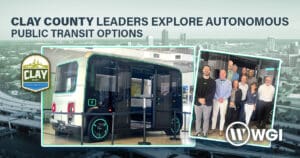By Ben Sands and Rob McConnell
Air travel has returned to pre-COVID levels, with more than half of Americans planning to fly this year. This is great news for airports, creating new opportunities and challenges, particularly when it comes to parking. More airline passengers means more demand for airport parking, particularly in areas with limited public transportation or rideshare options. More people than ever are driving themselves to the airport, and airport parking managers are finding new ways to accommodate these travelers.
Most airports are focusing on improving the client journey, trying to make it as comfortable and easy as possible, particularly for frequent travelers. For many travelers, the journey begins in an airport’s parking facility, and a seamless transition from personal vehicle to pedestrian to airline passenger is a key measure of success. With more competition from private, off-airport parking options, airport parking operations must be attractively priced and promote the convenience of parking on-site. Many airport operations are attempting to build brand loyalty with mobile device applications, rewards programs and the associated discounts and perks. And, along the way, if an airport is able to upsell services or direct customers to its concessionaires, so much the better.
Look to Technology
Part of the answer to improving the parking experience lies in technology. There are a number of parking technology trends that are well-suited for airports and that can significantly improve the customer journey while at the same time making parking more profitable and efficient to manage.
The most important trend today is automation. Most airports have minimized or altogether eliminated staffed exit cashiering. Airport parkers can pay for parking via mobile app or on foot at conveniently located pay stations rather than fumbling with a credit card or cash in the exit lane. This improves exiting throughput by 400% to 600%, reducing queues, traffic back-up, and the overall time it takes to exit. It also frees up parking staff from sitting in a booth all day to put their time to better use, such as assisting customers with operator/intercom customer assistance, concierge services, as well as providing in-lane customer assistance during peak period and/or performing maintenance tasks.
Most airports are already trying to eliminate cash transactions because credit card transactions are cleaner, quicker, more reliable, less subject to shrinkage (aka theft), and easier to manage. And they are succeeding. Today, cash has declined to 5-10% of transactions in most airport parking operations, if it is accepted at all. Modern parking access and revenue control systems can often also accept Apple Pay, Google Pay, and other smartphone-based payment options.
Many airports are taking automation a step further, installing license plate recognition (LPR) equipment at entrances and exits to provide a more frictionless experience. As a traveler pulls up to a gate, the LPR reads their plate and associates it with a paid stay or an established account. The gate raises, allowing the driver to pass without having to roll down the window or otherwise interacting with the system. Frictionless parking is much quicker than traditional manual payment approaches, particularly when it is barrierless as well. It is the perfect approach for airport parking because travelers are often in a rush to make a plane when they arrive and tired and anxious to exit the airport when they return.
Reservations
Parking reservations have become an essential element of airport parking in the post-covid world. Airport parking spaces, and in particular the most convenient parking areas, have always been in high demand. Parking reservations allow airports to better understand and manage their parking operations based on the actual demand for the various parking assets. If, for example, there is a high demand for close-in, short-term parking, an airport can allocate more of the parking spaces to that use and command a higher price. On the other hand, if parking demand is weaker on a particular day or for a particular facility, an airport can reduce the associated price and promote its availability and ease of use. Parking reservation systems enable airports to gain a real advance picture of demand rather than the traditional approach of projecting demand based on historical usage and guesswork.
Parking reservations also generally require prepayment, which essentially locks in revenue and removes the transaction from the parking process. Customers authorize credit card payment at the time of booking in exchange for guaranteed parking spaces. Parking spaces, like hotel rooms and airline seats, are a perishable commodity that quickly expires if not used. Like hotel and air reservations, parking reservations usually have cancellation policies that enable the operator to retain payment if a space is booked but not used.
Airports can link their reservations systems to loyalty programs to allow customers who reserve parking to earn loyalty benefits like discounted or free parking and in-terminal benefits. Additionally, airports can push out promotions and incentives through their loyalty programs for things such as discounted parking, particularly on weekends, when parking facilities tend to be less full due to fewer business travelers. Airport parking reservations platforms integrate into an airport’s parking website and mobile app, so the process is seamless, and the services carry the airport’s branding.
Ultimately, most airports want to get to the point where all parkers reserve a space before going to the airport. From a customer service perspective, this provides certainty to travelers that they’ll have a space waiting for them when they arrive. When parking reservations systems are coupled with parking guidance systems (PGS) within an airport’s parking facilities that direct drivers to the available parking spaces, the parking process becomes frictionless and much less stressful.
EV Challenges and Opportunities
The impending EV age is already posing challenges for airport parking managers. For instance, travelers tend to park in airport parking spaces for much longer periods of time than it takes to charge an electric vehicle. Airports need to implement policies to manage EV spaces as necessary.
Currently, there are a few operating strategies for EV charging at airports. One is to restrict EV charging to short-term parking areas only, ensuring that the charging spaces turn over frequently or incur a heavy penalty for overstay. Another strategy is to identify those vehicles occupying the EV charging spaces using mobile LPR. Those vehicles are then charged a supplemental fee for occupying those spaces, potentially escalating with time. A third approach is to restrict EV charging to valet areas only. In this scenario, airport parking staff move electric vehicles to and from EV charging equipment to ensure that the customer has a fully-charged vehicle when they arrive. A new technological twist on the valet approach entails the use of portable EV charging equipment. In this case, airport staff would move the charging equipment from vehicle to vehicle, providing only as much charge time as necessary. This requires an understanding of which customer vehicles are to be charged, where they are parked, and the anticipated arrival and departure, all of which ties into the parking reservations platform.
Another challenge associated with EV spaces is enforcement. It’s not uncommon for drivers to park gas-powered vehicles in EV spaces if they can’t find a regular space. This can be handled by installing cameras with video analytic software in EV charging areas to monitor that the spaces are being used properly. The software can be trained to identify improperly parked vehicles and direct enforcement. PGS can also go a long way to alleviate this issue by quickly directing drivers to the appropriate available parking spaces. Additionally, EV charging should not be restricted to the most convenient parking spaces in a facility. There are ample incentives for EV ownership beyond convenient airport parking, and, in any case, the EV charging equipment must be located directly adjacent to the electrical equipment to ensure efficiency from both a power and financial perspective.
EV charging presents opportunities too. Obviously, offering EV charging is a valuable customer amenity for travelers who drive electric vehicles. With the right equipment, EV charging can also be a source of revenue. Airports can even tie EV charging payment to their facilities’ Parking Access and Revenue Control Systems (PARCS) equipment so parkers can pay for both EV charging and parking in the same transaction. Not only does this simplify the management of EV payment, but it provides a more convenient experience for parkers.
Transportation Network Companies (TNC) Management
One challenge facing airports that is only tangentially related to parking is the tendency of TNC drivers to cause congestion by failing to stay within areas designated for drop-offs and pick-ups. While it’s difficult to manage drop-offs, airports can keep pick-ups in check with geofencing. With geofencing, airports can use GPS or RFID technology to create a virtual boundary and the direct TNC ride-hailing to work only within that boundary. This also enables black-listing of problematic drivers or companies. This is a great way to prevent TNCs from causing congestion in other areas near terminals.
Like the rest of the parking industry, airport parking has become extremely techno-centric. By implementing these technology strategies, airports can make parking much more convenient and, as a result, more competitive with off-airport competitors. Considering that parking is a vital source of revenue for airports—for many airports, the largest revenue source aside from gate fees—implementing these strategies should be at the top of every airport parking manager’s to-do list.
Rob McConnell, PE, SE, is Vice President – Parking at WGI, Inc. He can be reached at Rob.McConnell@wginc.com.
Ben Sands, CPP, is Manager of Parking Planning and Operations for WGI, Inc. He can be reached at Benjamin.Sands@wginc.com.
To read the original article on AviationPros.com, please visit the link HERE




















